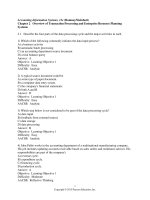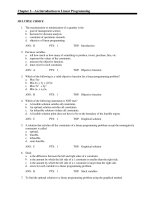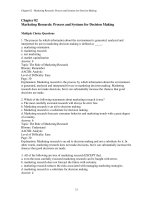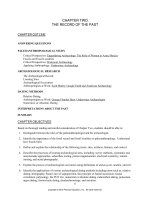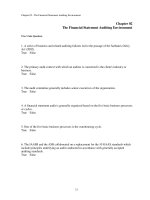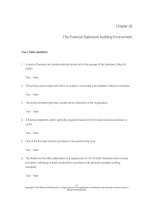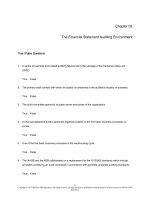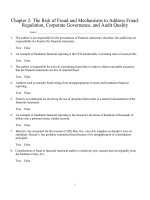A childs world 13th edition martorell test bank
Bạn đang xem bản rút gọn của tài liệu. Xem và tải ngay bản đầy đủ của tài liệu tại đây (198.32 KB, 70 trang )
Chapter 02 - A Child's World: How We Discover It
Chapter 02
A Child's World: How We Discover It
Multiple Choice Questions
1. A scientific theory is a set of
A. logically related statements seeking to describe, explain, and predict human behavior.
B. facts derived from research.
C. predictions about future outcomes.
D. opinions presented by a well-known authority in a field.
refer to page 24
APA LO: 1.2
Bloom's Taxonomy: Remember
Connect LO: 2.1: Explain the purposes theories serve, and two basic issues on which developmental theorists differ.
Learn Smart LO: Define scientific theory.
2. The statement, "If children learn aggression from models, then children who watch violent
television shows should be more aggressive than children who watch nonviolent shows," is an
example of a
A. theory.
B. finding.
C. hypothesis.
D. conclusion.
refer to page 24
APA LO: 1.2
Bloom's Taxonomy: Apply
Connect LO: 2.1: Explain the purposes theories serve, and two basic issues on which developmental theorists differ.
Learn Smart LO: Recall the definition of a hypothesis.
2-1
Copyright © 2014 McGraw-Hill Education. All rights reserved. No reproduction or distribution without the prior written consent of
McGraw-Hill Education.
Chapter 02 - A Child's World: How We Discover It
3. Before designing her research study, Dr. Bennett predicts that infants who have poor diets
will have academic problems later in life. Dr. Bennett's prediction is an example of a(n)
A. hypothesis.
B. theory.
C. interpretation.
D. conclusion.
refer to page 24
APA LO: 1.2
Bloom's Taxonomy: Apply
Connect LO: 2.1: Explain the purposes theories serve, and two basic issues on which developmental theorists differ.
Learn Smart LO: Recall the definition of a hypothesis.
4. Which of the following statements is true of scientific theories?
A. Theories are the possible explanations for phenomena.
B. Theories can be proved, but never disproved.
C. Theories change to incorporate new findings.
D. Theories are based on assumptions that are true.
refer to page 24
APA LO: 1.2
Bloom's Taxonomy: Understand
Connect LO: 2.1: Explain the purposes theories serve, and two basic issues on which developmental theorists differ.
Learn Smart LO: Define scientific theory.
5. Which of the following is NOT one of the basic issues that theorists address when
explaining child development?
A. Assessing whether development is more influenced by heredity or by environment
B. Determining whether children are active or passive in their own development
C. Observing whether development is continuous or occurs in stages
D. Viewing all development as culturally determined
refer to page 25
APA LO: 1.2
Bloom's Taxonomy: Understand
Connect LO: 2.1: Explain the purposes theories serve, and two basic issues on which developmental theorists differ.
Learn Smart LO: Recall the two basic issues that theorists make assumptions about in attempting to explain development.
2-2
Copyright © 2014 McGraw-Hill Education. All rights reserved. No reproduction or distribution without the prior written consent of
McGraw-Hill Education.
Chapter 02 - A Child's World: How We Discover It
6. At age 1, Suzi had a vocabulary of 10 words. Now, at 2 years of age, she has a vocabulary
of over 100 words. This reflects a(n) _____ developmental change.
A. autonomous
B. bidirectional
C. qualitative
D. quantitative
refer to page 26
APA LO: 1.2
Bloom's Taxonomy: Apply
Connect LO: 2.1: Explain the purposes theories serve, and two basic issues on which developmental theorists differ.
Learn Smart LO: Recognize that mechanistic theorists deal with quantitative change.
7. __________ viewed human development as being shaped by unconscious forces.
A. Sigmund Freud
B. B. F. Skinner
C. Jean Piaget
D. John B. Watson
refer to page 27
APA LO: 1.2
Bloom's Taxonomy: Remember
Connect LO: 2.2: Differentiate the five theoretical perspectives on child development, and identify theories that are representative of each.
Learn Smart LO: Recall the basic belief of Sigmund Freud.
8. Sigmund Freud believed that people are motivated primarily by
A. extrinsic rewards.
B. unconscious forces.
C. anxiety.
D. their environment.
refer to page 27
APA LO: 1.2
Bloom's Taxonomy: Remember
Connect LO: 2.2: Differentiate the five theoretical perspectives on child development, and identify theories that are representative of each.
Learn Smart LO: Recall the basic belief of Sigmund Freud.
2-3
Copyright © 2014 McGraw-Hill Education. All rights reserved. No reproduction or distribution without the prior written consent of
McGraw-Hill Education.
Chapter 02 - A Child's World: How We Discover It
9. Armond argues that unconscious forces motivate people to behave the way they do.
Armond's position is similar to the __________ perspective of development.
A. information-processing
B. cognitive
C. ethological
D. psychoanalytic
refer to page 27
APA LO: 1.2
Bloom's Taxonomy: Apply
Connect LO: 2.2: Differentiate the five theoretical perspectives on child development, and identify theories that are representative of each.
Learn Smart LO: Recall the basic belief of Sigmund Freud.
10. According to Freud, the element of personality that operates under the pleasure principal
is referred to as the
A. libido.
B. id.
C. superego.
D. ego.
refer to pages 27-28
APA LO: 1.2
Bloom's Taxonomy: Remember
Connect LO: 2.2: Differentiate the five theoretical perspectives on child development, and identify theories that are representative of each.
Learn Smart LO: Distinguish between the three parts of the personality according to Freud.
2-4
Copyright © 2014 McGraw-Hill Education. All rights reserved. No reproduction or distribution without the prior written consent of
McGraw-Hill Education.
Chapter 02 - A Child's World: How We Discover It
11. Parents who are up all night attending to the almost insatiable demands of their newborn
babies are often frustrated by infants' apparent tendency to operate on the "pleasure principle."
The pleasure principle is associated with the
A. id.
B. ego.
C. superego.
D. ego ideal.
refer to pages 27-28
APA LO: 1.2
Bloom's Taxonomy: Understand
Connect LO: 2.2: Differentiate the five theoretical perspectives on child development, and identify theories that are representative of each.
Learn Smart LO: Distinguish between the three parts of the personality according to Freud.
12. According to Freud, during the first year of life, the part of the personality that represents
reason and operates on the "reality principle" becomes more evident in the baby's behavior.
This is due to the development of the
A. id.
B. ego.
C. superego.
D. conscience.
refer to pages 27-28
APA LO: 1.2
Bloom's Taxonomy: Remember
Connect LO: 2.2: Differentiate the five theoretical perspectives on child development, and identify theories that are representative of each.
Learn Smart LO: Distinguish between the three parts of the personality according to Freud.
2-5
Copyright © 2014 McGraw-Hill Education. All rights reserved. No reproduction or distribution without the prior written consent of
McGraw-Hill Education.
Chapter 02 - A Child's World: How We Discover It
13. Freud maintained that children develop in an unvarying sequence of five maturation-based
stages of _____ development.
A. psychosocial
B. psychoanalytic
C. unconscious
D. psychosexual
refer to page 29
APA LO: 1.2
Bloom's Taxonomy: Remember
Connect LO: 2.2: Differentiate the five theoretical perspectives on child development, and identify theories that are representative of each.
Learn Smart LO: Identify the five stages of psychosexual development according to Freud.
14. According to Freud, children move through five stages of psychosexual development. The
sequence of these stages is
A. anal, phallic, oral, latency, and, genital.
B. oral, anal, phallic, latency, and, genital.
C. anal, oral, genital, latency, and, phallic.
D. oral, latency, genital, anal, and, phallic.
refer to page 29
APA LO: 1.2
Bloom's Taxonomy: Remember
Connect LO: 2.2: Differentiate the five theoretical perspectives on child development, and identify theories that are representative of each.
Learn Smart LO: Identify the five stages of psychosexual development according to Freud.
2-6
Copyright © 2014 McGraw-Hill Education. All rights reserved. No reproduction or distribution without the prior written consent of
McGraw-Hill Education.
Chapter 02 - A Child's World: How We Discover It
15. According to Freud's theory, a 4-year-old child who has become attached to the parent of
the other sex and regards the same-sex parent as a rival is considered to be in the __________
stage of psychosexual development.
A. oral
B. anal
C. phallic
D. latency
refer to page 29
APA LO: 1.2
Bloom's Taxonomy: Apply
Connect LO: 2.2: Differentiate the five theoretical perspectives on child development, and identify theories that are representative of each.
Learn Smart LO: Describe Freud's phallic stage of psychosexual development.
16. Joseph hits his brother with a toy while playing and feels guilty about it afterwards.
According to Freud, these feelings reflect the operation of the
A. id.
B. ego.
C. superego.
D. defense mechanism.
refer to pages 27-29
APA LO: 1.2
Bloom's Taxonomy: Apply
Connect LO: 2.2: Differentiate the five theoretical perspectives on child development, and identify theories that are representative of each.
Learn Smart LO: Distinguish between the three parts of the personality according to Freud.
2-7
Copyright © 2014 McGraw-Hill Education. All rights reserved. No reproduction or distribution without the prior written consent of
McGraw-Hill Education.
Chapter 02 - A Child's World: How We Discover It
17. Keesha is worried that her mother will find out that she accidentally broke her brother's
truck. She is starting to develop a conscience. Which of the following psychosexual stages
includes our conception of a "conscience?"
A. Id
B. Ego
C. Superego
D. Libido
refer to page 29
APA LO: 1.2
Bloom's Taxonomy: Apply
Connect LO: 2.2: Differentiate the five theoretical perspectives on child development, and identify theories that are representative of each.
Learn Smart LO: Distinguish between the three parts of the personality according to Freud.
18. Mrs. Dobber, a teacher, believes that fourth graders are at a stage of psychosexual
development characterized by relative calm. Mrs. Dobber's students are in the _________
stage, which occurs during middle childhood.
A. phallic
B. superego
C. latency
D. generative
refer to page 29
APA LO: 1.2
Bloom's Taxonomy: Apply
Connect LO: 2.2: Differentiate the five theoretical perspectives on child development, and identify theories that are representative of each.
Learn Smart LO: Describe Freud's latency stage of psychosexual development.
2-8
Copyright © 2014 McGraw-Hill Education. All rights reserved. No reproduction or distribution without the prior written consent of
McGraw-Hill Education.
Chapter 02 - A Child's World: How We Discover It
19. Each of Erikson's stages of development involves a psychosocial challenge, or _______,
hat is important at a particular time.
A. trauma
B. crises
C. historical event
D. phase
refer to page 31
APA LO: 1.2
Bloom's Taxonomy: Remember
Connect LO: 2.2: Differentiate the five theoretical perspectives on child development, and identify theories that are representative of each.
Learn Smart LO: Discuss Erikson's psychosocial theory of development.
20. A major distinction between Freud's and Erikson's views of development is that Erikson
A. emphasized female development, whereas Freud emphasized male development.
B. viewed development as a lifelong process, whereas Freud emphasized early experiences.
C. focused on unconscious processes, whereas Freud emphasized conscious processes.
D. emphasized biological factors, whereas Freud emphasized cultural factors.
refer to page 31
APA LO: 5.1
Bloom's Taxonomy: Understand
Connect LO: 2.2: Differentiate the five theoretical perspectives on child development, and identify theories that are representative of each.
Learn Smart LO: Discuss Erikson's psychosocial theory of development.
2-9
Copyright © 2014 McGraw-Hill Education. All rights reserved. No reproduction or distribution without the prior written consent of
McGraw-Hill Education.
Chapter 02 - A Child's World: How We Discover It
21. As an assignment for a developmental psychology class, Darius interviewed his
grandparents to learn more about their life experiences. In the interview, Darius learned that
his grandparents view development as lifelong. The idea that personality development occurs
throughout the life span is consistent with ______ theory.
A. Freud's psychosexual
B. Erikson's psychosocial
C. Bandura's social learning
D. Bowlby's ethological
refer to page 31
APA LO: 1.2
Bloom's Taxonomy: Apply
Connect LO: 2.2: Differentiate the five theoretical perspectives on child development, and identify theories that are representative of each.
Learn Smart LO: Discuss Erikson's psychosocial theory of development.
22. In Erikson's theory of development, there are ___ stages of psychosocial development.
A. 3
B. 5
C. 8
D. 12
refer to page 31
APA LO: 1.2
Bloom's Taxonomy: Remember
Connect LO: 2.2: Differentiate the five theoretical perspectives on child development, and identify theories that are representative of each.
Learn Smart LO: Discuss Erikson's psychosocial theory of development.
2-10
Copyright © 2014 McGraw-Hill Education. All rights reserved. No reproduction or distribution without the prior written consent of
McGraw-Hill Education.
Chapter 02 - A Child's World: How We Discover It
23. Compared to Freud's theory, Erikson placed greater emphasis on
A. physical development.
B. intellectual development.
C. early experiences.
D. social and cultural influences.
refer to page 31
APA LO: 1.2
Bloom's Taxonomy: Understand
Connect LO: 2.2: Differentiate the five theoretical perspectives on child development, and identify theories that are representative of each.
Learn Smart LO: Discuss Erikson's psychosocial theory of development.
24. A long-lasting change in behavior as a result of experience or adaptation to the
environment is called
A. modification.
B. cognition.
C. learning.
D. behaviorism.
refer to page 31
APA LO: 5.1
Bloom's Taxonomy: Remember
Connect LO: 2.2: Differentiate the five theoretical perspectives on child development, and identify theories that are representative of each.
Learn Smart LO: Discuss perspective two: Learning.
25. Behaviorists look for events that will determine whether or not a particular behavior will
be repeated. This mental link is referred to as
A. associative learning.
B. unconscious learning.
C. intelligence.
D. personality.
refer to page 31
APA LO: 5.1
Bloom's Taxonomy: Remember
Connect LO: 2.2: Differentiate the five theoretical perspectives on child development, and identify theories that are representative of each.
Learn Smart LO: Recall associative learning.
2-11
Copyright © 2014 McGraw-Hill Education. All rights reserved. No reproduction or distribution without the prior written consent of
McGraw-Hill Education.
Chapter 02 - A Child's World: How We Discover It
26. Every time Tanya leaves 2-year-old Timmy at day care, Timmy cries. Tanya always hands
Timmy to the same teacher. She notices that Timmy now starts to cry when he sees this
teacher from a distance. Timmy's behavior is an example of
A. classical conditioning.
B. operant conditioning.
C. social learning.
D. negative reinforcement.
refer to page 32
APA LO: 5.1
Bloom's Taxonomy: Apply
Connect LO: 2.2: Differentiate the five theoretical perspectives on child development, and identify theories that are representative of each.
Learn Smart LO: Recall classical conditioning.
27. Daniel was embarrassed by his coach for not making a basket during an important game.
Since then, whenever he gets the ball and heads down the court, he gets an overwhelming
feeling of anxiety that prevents him from thinking clearly when he tries to shoot the ball. This
is an example of
A. operant conditioning.
B. classical conditioning.
C. social learning.
D. intermittent reinforcement.
refer to page 32
APA LO: 5.1
Bloom's Taxonomy: Apply
Connect LO: 2.2: Differentiate the five theoretical perspectives on child development, and identify theories that are representative of each.
Learn Smart LO: Recall classical conditioning.
2-12
Copyright © 2014 McGraw-Hill Education. All rights reserved. No reproduction or distribution without the prior written consent of
McGraw-Hill Education.
Chapter 02 - A Child's World: How We Discover It
28. When John B. Watson trained "Little Albert" to be afraid of small furry animals, he used
A. classical conditioning.
B. negative reinforcement.
C. shaping behavior.
D. intermittent reinforcement.
refer to page 32
APA LO: 5.1
Bloom's Taxonomy: Remember
Connect LO: 2.2: Differentiate the five theoretical perspectives on child development, and identify theories that are representative of each.
Learn Smart LO: Recall classical conditioning.
29. Mr. Whitford's fifth-grade students sit quietly and continue doing their work when Mr.
Whitford leaves the room because he rewards them with more recess time if they do so.
Learning based on association of behavior with consequences is called
A. classical conditioning.
B. operant conditioning.
C. the pleasure principle.
D. the reality principle.
refer to page 32
APA LO: 5.1
Bloom's Taxonomy: Apply
Connect LO: 2.2: Differentiate the five theoretical perspectives on child development, and identify theories that are representative of each.
Learn Smart LO: Discuss Skinner's operant conditioning theory.
2-13
Copyright © 2014 McGraw-Hill Education. All rights reserved. No reproduction or distribution without the prior written consent of
McGraw-Hill Education.
Chapter 02 - A Child's World: How We Discover It
30. Marissa really wants to be in the school play but does not enjoy having to memorize lines.
Two weeks before the play is scheduled, her father implements a reward system. As soon as
Marissa learns her lines, she does not have to help with the dishes until the play is over.
Marissa increases her efforts in practice and learns the lines thoroughly in two days. This is an
example of
A. classical conditioning.
B. operant conditioning.
C. social learning.
D. psychodynamic learning.
refer to page 32
APA LO: 5.1
Bloom's Taxonomy: Apply
Connect LO: 2.2: Differentiate the five theoretical perspectives on child development, and identify theories that are representative of each.
Learn Smart LO: Discuss Skinner's operant conditioning theory.
31. B. F. Skinner and other behaviorists maintain that human behavior is determined by
A. defense mechanisms.
B. self-actualization.
C. unconscious conflicts.
D. conditioning.
refer to page 32
APA LO: 5.1
Bloom's Taxonomy: Remember
Connect LO: 2.2: Differentiate the five theoretical perspectives on child development, and identify theories that are representative of each.
Learn Smart LO: Discuss Skinner's operant conditioning theory.
2-14
Copyright © 2014 McGraw-Hill Education. All rights reserved. No reproduction or distribution without the prior written consent of
McGraw-Hill Education.
Chapter 02 - A Child's World: How We Discover It
32. _____ was the American psychologist who formulated the principles of operant
conditioning while working with rats and pigeons.
A. John B. Watson
B. Sidney Pressey
C. B. F. Skinner
D. Ivan Pavlov
refer to page 32
APA LO: 5.1
Bloom's Taxonomy: Remember
Connect LO: 2.2: Differentiate the five theoretical perspectives on child development, and identify theories that are representative of each.
Learn Smart LO: Discuss Skinner's operant conditioning theory.
33. Larry wants his daughter to put her seat belt on when she gets in the car, so he smiles and
gives her a hug each time she does so. A consequence of any behavior that increases the
likelihood of that behavior being repeated is called
A. punishment.
B. reinforcement.
C. aversion.
D. classical conditioning.
refer to page 32
APA LO: 5.1
Bloom's Taxonomy: Apply
Connect LO: 2.2: Differentiate the five theoretical perspectives on child development, and identify theories that are representative of each.
Learn Smart LO: Describe reinforcement.
2-15
Copyright © 2014 McGraw-Hill Education. All rights reserved. No reproduction or distribution without the prior written consent of
McGraw-Hill Education.
Chapter 02 - A Child's World: How We Discover It
34. An example of negative reinforcement is
A. shouting, "No!" as a consequence of bad behavior.
B. spanking as a consequence of bad behavior.
C. increasing a child's allowance as a consequence of good behavior.
D. canceling a disliked household chore as a consequence of good behavior.
refer to page 32
APA LO: 5.1
Bloom's Taxonomy: Understand
Connect LO: 2.2: Differentiate the five theoretical perspectives on child development, and identify theories that are representative of each.
Learn Smart LO: Describe reinforcement.
35. June's mother explains that she needs help taking care of their new puppy. June's current
task, which she really dislikes, is taking the garbage out. Her mother says that if June will
help take care of the puppy, she will assign another sibling to take out the garbage. June
agrees immediately, because she will do anything to get out of emptying the garbage. From a
behavioral viewpoint, June's decision is based on
A. classical conditioning.
B. positive reinforcement.
C. negative reinforcement.
D. vicarious reinforcement.
refer to page 32
APA LO: 5.1
Bloom's Taxonomy: Apply
Connect LO: 2.2: Differentiate the five theoretical perspectives on child development, and identify theories that are representative of each.
Learn Smart LO: Describe reinforcement.
2-16
Copyright © 2014 McGraw-Hill Education. All rights reserved. No reproduction or distribution without the prior written consent of
McGraw-Hill Education.
Chapter 02 - A Child's World: How We Discover It
36. The parents of 15-month-old Helen want to discourage her thumb sucking. When Helen
takes her thumb out of her mouth, they give her a small cup of raisins, which she loves. The
raisins represent
A. a negative stimulus.
B. an unconditioned stimulus.
C. a neutral stimulus.
D. reinforcement.
refer to page 32
APA LO: 5.1
Bloom's Taxonomy: Apply
Connect LO: 2.2: Differentiate the five theoretical perspectives on child development, and identify theories that are representative of each.
Learn Smart LO: Describe reinforcement.
37. Two-year-old Eric throws a tantrum whenever he is placed in his car seat. To calm him
down, his mother has started giving him a lollipop. In effect, his mother is
A. extinguishing tantrums.
B. reinforcing tantrums.
C. using classical conditioning.
D. using negative reinforcement.
refer to page 32
APA LO: 5.1
Bloom's Taxonomy: Apply
Connect LO: 2.2: Differentiate the five theoretical perspectives on child development, and identify theories that are representative of each.
Learn Smart LO: Describe reinforcement.
2-17
Copyright © 2014 McGraw-Hill Education. All rights reserved. No reproduction or distribution without the prior written consent of
McGraw-Hill Education.
Chapter 02 - A Child's World: How We Discover It
38. Every time Billy tries to open the kitchen cupboard, he gets his fingers pinched in the door.
Eventually, Billy no longer tries to open the cupboard door. This is an example of
A. negative reinforcement.
B. intermittent reinforcement.
C. punishment.
D. positive reinforcement.
refer to page 32
APA LO: 5.1
Bloom's Taxonomy: Apply
Connect LO: 2.2: Differentiate the five theoretical perspectives on child development, and identify theories that are representative of each.
Learn Smart LO: Describe punishment.
39. To get Michelle to clean her room more often, her parents gave her a piece of candy each
time she picked up her toys. This resulted in more frequent room cleaning. However, when
her parents stopped giving her candy, Michelle's room-cleaning behavior gradually became
less frequent. The weakening of the room-cleaning behavior is called
A. intermittent reinforcement.
B. extinction.
C. punishment.
D. negative reinforcement.
refer to page 33
APA LO: 5.1
Bloom's Taxonomy: Apply
Connect LO: 2.2: Differentiate the five theoretical perspectives on child development, and identify theories that are representative of each.
Learn Smart LO: Recall how behavior is extinguished.
2-18
Copyright © 2014 McGraw-Hill Education. All rights reserved. No reproduction or distribution without the prior written consent of
McGraw-Hill Education.
Chapter 02 - A Child's World: How We Discover It
40. Whenever Milo had a tantrum, his father would pick him up and comfort him. Now that
he is in preschool, his teachers ignore his tantrums, and over time his tantrums have decreased
in frequency. Based on our understanding of operant conditioning, we would say that Milo's
tantrum behavior is being __________ in preschool.
A. negatively reinforced
B. punished
C. extinguished
D. aversively conditioned
refer to page 33
APA LO: 5.1
Bloom's Taxonomy: Apply
Connect LO: 2.2: Differentiate the five theoretical perspectives on child development, and identify theories that are representative of each.
Learn Smart LO: Recall how behavior is extinguished.
41. When a school principal uses operant conditioning to eliminate students' undesirable
behaviors, he is implementing
A. classical conditioning.
B. punishment.
C. behavior modification.
D. reinforcement.
refer to page 33
APA LO: 5.1
Bloom's Taxonomy: Understand
Connect LO: 2.2: Differentiate the five theoretical perspectives on child development, and identify theories that are representative of each.
Learn Smart LO: Describe behavior modification.
2-19
Copyright © 2014 McGraw-Hill Education. All rights reserved. No reproduction or distribution without the prior written consent of
McGraw-Hill Education.
Chapter 02 - A Child's World: How We Discover It
42. First, Jacob is praised when he points to his wet diaper. Then, Jacob is praised only if he
speaks up before he is wet. Finally, Jacob is praised only when he uses his potty chair. This is
an example of
A. extinction.
B. behavior modification.
C. negative reinforcement.
D. aversive conditioning.
refer to page 33
APA LO: 5.1
Bloom's Taxonomy: Apply
Connect LO: 2.2: Differentiate the five theoretical perspectives on child development, and identify theories that are representative of each.
Learn Smart LO: Describe behavior modification.
43. ________ developed the principles of social-learning theory.
A. B. F. Skinner
B. Carl Rogers
C. John B. Watson.
D. Albert Bandura
refer to page 33
APA LO: 5.2
Bloom's Taxonomy: Remember
Connect LO: 2.2: Differentiate the five theoretical perspectives on child development, and identify theories that are representative of each.
Learn Smart LO: Define observational learning.
2-20
Copyright © 2014 McGraw-Hill Education. All rights reserved. No reproduction or distribution without the prior written consent of
McGraw-Hill Education.
Chapter 02 - A Child's World: How We Discover It
44. Albert Bandura suggested that the most important element in how children acquire
language, deal with aggression, develop a sense of morality, and learn gender-appropriate
behavior is
A. classical conditioning.
B. observation and imitation.
C. punishment of inappropriate behavior.
D. shaping of appropriate behavior.
refer to page 33
APA LO: 5.2
Bloom's Taxonomy: Understand
Connect LO: 2.2: Differentiate the five theoretical perspectives on child development, and identify theories that are representative of each.
Learn Smart LO: Define observational learning.
45. Children have a tendency to imitate the adults they admire even if some of the observed
behavior is not appropriate. This process is known as
A. behavior modification.
B. assimilation.
C. adaptation.
D. social learning.
refer to page 33
APA LO: 5.2
Bloom's Taxonomy: Understand
Connect LO: 2.2: Differentiate the five theoretical perspectives on child development, and identify theories that are representative of each.
Learn Smart LO: Define observational learning.
2-21
Copyright © 2014 McGraw-Hill Education. All rights reserved. No reproduction or distribution without the prior written consent of
McGraw-Hill Education.
Chapter 02 - A Child's World: How We Discover It
46. Roberto's favorite type of music is American Jazz. After observing a classmate being
teased for mentioning that she loved to listen to classical music, Roberto decided that he
would keep quiet about his musical preferences. Roberto's decision is a result of
A. classical conditioning.
B. operant conditioning.
C. social learning.
D. psychodynamic learning.
refer to page 33
APA LO: 1.2
Bloom's Taxonomy: Apply
Connect LO: 2.2: Differentiate the five theoretical perspectives on child development, and identify theories that are representative of each.
Learn Smart LO: Define observational learning.
47. By receiving feedback on their behavior, children gradually form standards for judging
their own actions. They begin to develop a
A. sense of self-efficacy.
B. superego.
C. gender identity.
D. sense of self-esteem.
refer to page 33
APA LO: 1.2
Bloom's Taxonomy: Understand
Connect LO: 2.2: Differentiate the five theoretical perspectives on child development, and identify theories that are representative of each.
Learn Smart LO: Understand the development of self-efficacy.
2-22
Copyright © 2014 McGraw-Hill Education. All rights reserved. No reproduction or distribution without the prior written consent of
McGraw-Hill Education.
Chapter 02 - A Child's World: How We Discover It
48. The ______ perspective focuses on thought processes and the behavior that reflects those
processes.
A. cognitive
B. behaviorist
C. psychodynamic
D. evolutionary
refer to page 33
APA LO: 1.2
Bloom's Taxonomy: Remember
Connect LO: 2.2: Differentiate the five theoretical perspectives on child development, and identify theories that are representative of each.
Learn Smart LO: Understand perspective 3: Cognitive.
49. Which theory portrays people as active in their own learning and emphasizes qualitative
and quantitative changes?
A. Behaviorist
B. Cognitive
C. Psychoanalytic
D. Social learning
refer to page 33
APA LO: 5.2
Bloom's Taxonomy: Remember
Connect LO: 2.2: Differentiate the five theoretical perspectives on child development, and identify theories that are representative of each.
Learn Smart LO: Understand perspective 3: Cognitive.
50. Neo-Piagetian theories combine both Piagetian theory and elements of _____ theory.
A. social cognitive
B. information-processing
C. behavioral
D. mechanistic
refer to page 33
APA LO: 5.2
Bloom's Taxonomy: Understand
Connect LO: 2.2: Differentiate the five theoretical perspectives on child development, and identify theories that are representative of each.
Learn Smart LO: Understand perspective 3: Cognitive.
2-23
Copyright © 2014 McGraw-Hill Education. All rights reserved. No reproduction or distribution without the prior written consent of
McGraw-Hill Education.
Chapter 02 - A Child's World: How We Discover It
51. Which of the following are the two key points of Piaget's cognitive perspective?
A. People are controlled by their environment, and behavior develops in a specific order.
B. People are active in their development, and behavior is random at any developmental stage.
C. People are active in their development, and behavior develops in a specific order.
D. People are controlled by their environment, and behavior is random at any developmental
stage.
refer to pages 33-34
APA LO: 5.2
Bloom's Taxonomy: Understand
Connect LO: 2.2: Differentiate the five theoretical perspectives on child development, and identify theories that are representative of each.
Learn Smart LO: Describe Piaget's theory of cognitive development.
52. Which of the following is NOT a general principle of Piaget's theory of cognitive
development?
A. Children proceed through the same developmental stages in the same order.
B. Individuals reach each stage according to their own timetable.
C. If overgratification occurs at a particular stage, fixation may result.
D. Each stage represents a qualitative change from one type of thinking to another.
refer to pages 33-34
APA LO: 5.2
Bloom's Taxonomy: Understand
Connect LO: 2.2: Differentiate the five theoretical perspectives on child development, and identify theories that are representative of each.
Learn Smart LO: Describe Piaget's theory of cognitive development.
2-24
Copyright © 2014 McGraw-Hill Education. All rights reserved. No reproduction or distribution without the prior written consent of
McGraw-Hill Education.
Chapter 02 - A Child's World: How We Discover It
53. Anabelle knows that after she is fed her bottle, she is patted on the back and put down to
sleep. This organized pattern of behavior is called
A. equilibration.
B. accommodation.
C. assimilation.
D. a scheme.
refer to page 34
APA LO: 5.2
Bloom's Taxonomy: Apply
Connect LO: 2.2: Differentiate the five theoretical perspectives on child development, and identify theories that are representative of each.
Learn Smart LO: Define schemes.
54. According to Piaget, a child builds internal representations of the world called schemes,
and develops these into an integrated network of cognitive structures through the process of
A. assimilation.
B. accommodation.
C. organization.
D. equilibration.
refer to page 34
APA LO: 5.2
Bloom's Taxonomy: Understand
Connect LO: 2.2: Differentiate the five theoretical perspectives on child development, and identify theories that are representative of each.
Learn Smart LO: Illustrate Piaget's concept of organization.
2-25
Copyright © 2014 McGraw-Hill Education. All rights reserved. No reproduction or distribution without the prior written consent of
McGraw-Hill Education.
